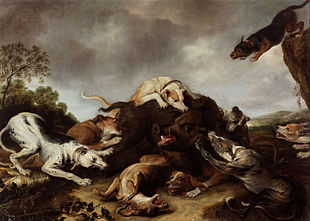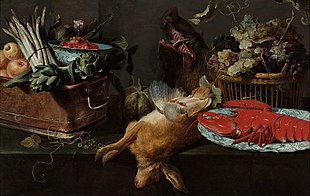Frans Snyders
A versatile artist, his works depict all sorts of foods, utensils, and tableware and wide assortment of animals.He was a regular collaborator with leading Antwerp painters such as Peter Paul Rubens, Anthony van Dyck, Jacob Jordaens, and Abraham Janssens.[3] Snyders was born in Antwerp as the son of Jan Snijders, the keeper of a wine inn frequented by artists.[3] Snyders had many patrons including the Ghent Bishop Antonius Triest who commissioned four paintings of market scenes around 1615 (Hermitage Museum, Saint Petersburg).[3] In the period 1636–1638, he was one of the Antwerp artists who assisted Rubens in a large commission for decorations for the hunting pavilion Torre de la Parada of Philip IV of Spain.His pupils are believed to have included Nicasius Bernaerts, Peter van Boucle, Juriaen Jacobsze, Jan Roos and Paul de Vos.[9] Peter van Boucle claimed that he was a pupil of Frans Snyders but there are no written sources available in Antwerp that support this contention.His style gradually matured as a result of his exposure to Italian art during his trip to Italy and the work of Rubens after his return to Antwerp.As a result, the dark surroundings of his early still lifes disappeared after 1614 and he became a fine colourist with strong compositional skills allowing him to structure a profusion of disparate objects.Rather than continue the descriptive manner of the Antwerp painter Osias Beert, Snyders' innovative still lifes combined objects in groups to form a geometrically structured composition.Recurring motifs were dead hares and birds, tazze (shallow dishes on a tall foot), baskets with grapes and other fruit, enamelled pitchers and Chinese Kraak porcelain.[15] Snyders is believed to have been a skilled figure painter in his own right as is evidenced by Jan Breughel the Elder's request that he make a copy after a Titian portrait in the Borromeo collection during his stay in Milan.In the early period of their collaboration, Rubens would paint an oil sketch of the complete composition and mark out clearly where Snyders would have to put his contribution.Other art historians regard the hunting scenes of de Vos as more dynamic and evidencing a more personal style when compared with those of Snyders, who was more a still life painter.[19] Snyders also painted the still life elements for other Antwerp painters such as Jacob Jordaens, Thomas Willeboirts Bosschaert, Jan Janssens and other artists.So, more generally, the concert of birds imagery refers to the political harmony and social order enjoyed by the owners of these paintings during the time the Southern Netherlands were governed by the Archdukes of Austria Albert and Isabella Clara Eugenia.Various followers of Snyders also painted this theme: in the Spanish Netherlands there were Paul de Vos, Jan Fyt and Jan van Kessel the Elder; in the Dutch Republic, Gijsbert d'Hondecoeter, his son Melchior d'Hondecoeter, Abraham Busschop and Jacobus Victors reworked the subject by making it more courtly; and in France the Flemish expatriates Nicasius Bernaerts or Pieter Boel also created compositions on the theme.Through their uncontrolled grabbing and consuming of food the monkeys show their barbaric nature which is driven solely by animal instinct and desire.The Louvre compositions with capuchin monkeys can also be interpreted as a form of vanitas paintings: the fruit in these still lifes is appetizing yet bound to perish.










Anthony van DyckAntwerpFlemishpainteranimalsstill lifesanimaliersPeter Paul RubensJacob JordaensAbraham JanssensFrans FlorisPieter Brueghel the YoungerHendrick van BalenGuild of Saint LukeJan Brueghel the Elderart collectorCardinal BorromeoTitianCornelis de VosPaul de VosHermitage MuseumFrick CollectionKasselTorre de la ParadaPhilip IV of SpainRoyal Alcazar of MadridBuen Retiro PalaceDutch RepublicbeguineMatthijs MussonJacob Foppens van EsWillem Claeszoon HedaLucas van LeydenJan LievensLambert LombardJan MassysJoachim PatinirAdriaen van UtrechtFrans YkensNicasius BernaertsPeter van BoucleJuriaen JacobszeJan RoosJan FytJean-Baptiste OudryFrançois DesportesJean-Baptiste-Siméon ChardinCaravaggioBasket of FruitPieter AertsenJoachim BeuckelaerManneristOsias BeertKraak porcelainJan Davidsz. de HeemMuseum of Fine Arts, BostonRubensTheodoor van ThuldenJan BoeckhorstJan WildensMedusaKunsthistorisches MuseumViennaThomas Willeboirts BosschaertJan JanssensAeolusMiddle AgesFrancis of AssisiFranciscanBeeldenstormliturgyAlbertIsabella Clara EugeniaJan van Kessel the ElderGijsbert d'HondecoeterMelchior d'HondecoeterAbraham BusschopPieter BoelRaggiana bird-of-paradiseLouvrecapuchin monkeysvanitasChisholm, HughEncyclopædia BritannicaWayback MachineNetherlands Institute for Art History